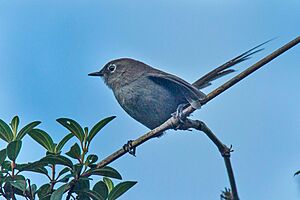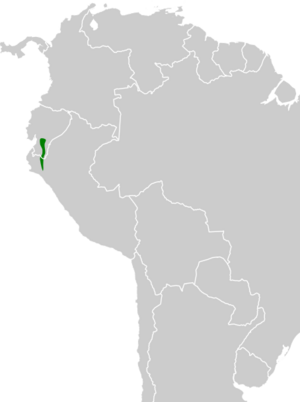Mouse-colored thistletail facts for kids
Quick facts for kids Mouse-colored thistletail |
|
|---|---|
 |
|
| Conservation status | |
| Scientific classification | |
| Genus: |
Asthenes
|
| Species: |
griseomurina
|
 |
|
| Synonyms | |
|
Schizoeaca griseomurina |
|
The mouse-colored thistletail (Asthenes griseomurina) is a small bird that lives in the Andes Mountains of Ecuador and Peru. It belongs to the ovenbird family, which is known for building unique nests. This bird gets its name from its dull, mouse-like gray-brown feathers and its ragged, forked tail that looks a bit like a thistle.
Contents
About the Mouse-colored Thistletail
This bird is part of the ovenbird family, called Furnariidae. It's related to many other "thistletails." Scientists used to think it was a subspecies of the white-chinned thistletail. They also used to place it in a different group, or genus, called Schizoeaca. However, new genetic studies showed it actually belongs in the Asthenes genus. The mouse-colored thistletail is a unique species, meaning it doesn't have different subspecies.
What Does It Look Like?
The mouse-colored thistletail is about 18 to 21 cm (7.1 to 8.3 in) long. That's about the length of a standard pencil. It weighs between 15.5 to 19 g (0.55 to 0.67 oz), which is lighter than a few quarters. Both male and female birds look the same.
Feather Colors and Markings
These birds have a light gray-brown stripe above their eyes, called a supercilium. They also have a white ring around their eyes. The rest of their face is gray. Their head, back, and wings are a dull olive-brown color. Their tail is long and deeply forked, with feathers that look a bit ragged at the ends.
Their throat is pale gray or grayish brown, sometimes with faint white streaks on the chin. The rest of their belly and underside are pale grayish brown. Their eyes are brown. Their upper beak is dark gray, and their lower beak is a lighter gray. Their legs and feet are blue-gray.
Where Does It Live?
The mouse-colored thistletail lives in the Andes Mountains. You can find it on both sides of the mountains. Its range stretches from southern Ecuador into northern Peru. It also lives in a separate mountain range in Peru called the Cordillera del Cóndor.
Its Home Environment
This bird likes to live in high-altitude grasslands called páramo. It also lives at the tree line, where the grasslands meet cloudforests. Sometimes, it can be found in special woodlands with Polylepis trees.
In Ecuador, it usually lives between 2,800 and 4,000 m (9,200 and 13,100 ft) high. That's very high up in the mountains! Sometimes, it can be found a bit lower, around 2,500 m (8,200 ft). In Peru's Andes, it lives between 2,900 and 3,300 m (9,500 and 10,800 ft). In the Cordillera del Cóndor, it lives at about 2,150 m (7,100 ft).
How Does It Behave?
Movement
The mouse-colored thistletail stays in the same area all year round. It does not migrate.
Feeding Habits
Scientists don't know all the details about what this bird eats. However, they know it mainly eats arthropods, like insects and spiders. It usually looks for food in pairs. It rarely joins larger groups of different bird species that are feeding together. The bird finds its food close to the ground, picking prey off leaves and small branches.
Reproduction
Not much is known about how the mouse-colored thistletail reproduces. Scientists are still learning about its breeding habits.
Vocalization
The mouse-colored thistletail has a unique song. It sounds like a trill that gets faster and louder. It also goes down slightly in pitch. The song lasts about two seconds and is repeated every six seconds. Some people describe it as "kee kee-keekeekrkrrr...rrrrrr".
Another description of its song is a series of notes that speed up into a trill. The first notes sound like "sweeí, sweeí, sweeí, swi, ti-ti-titi-trrrrr". It also makes different calls. One call is a high-pitched sound that goes down, like "pseeeeuw". Other calls include a loud "riek", "tzeeek", or "weeek". It can also make a rising, whiny sound like "wee?" and "pee".
Conservation Status
The IUCN (International Union for Conservation of Nature) has evaluated the mouse-colored thistletail. They have listed it as a species of "Least Concern." This means it is not currently considered to be in danger of extinction.
However, it lives in a small area, and its total population size is unknown. Scientists believe its numbers might be decreasing. No major threats have been found that would immediately harm the species. It is thought to be uncommon to fairly common in Ecuador and fairly common in Peru. Human activities probably don't affect this bird much, except for local habitat destruction.


